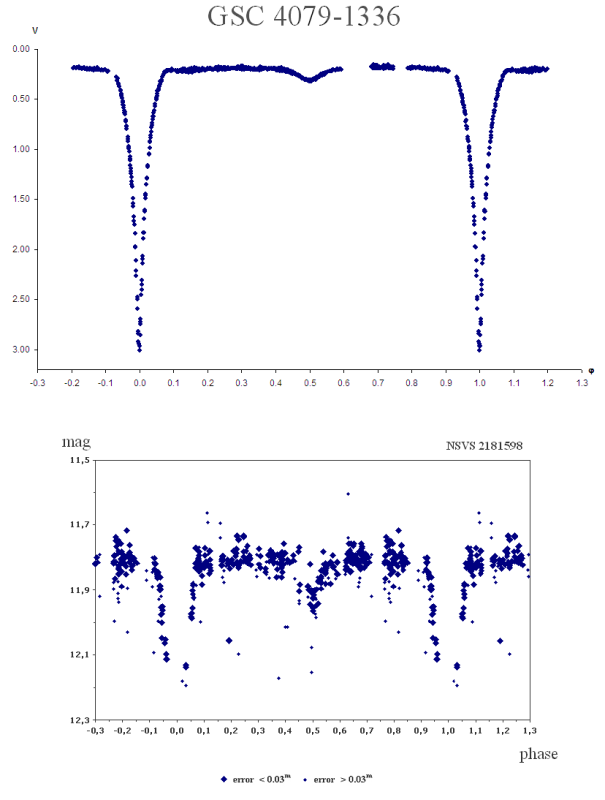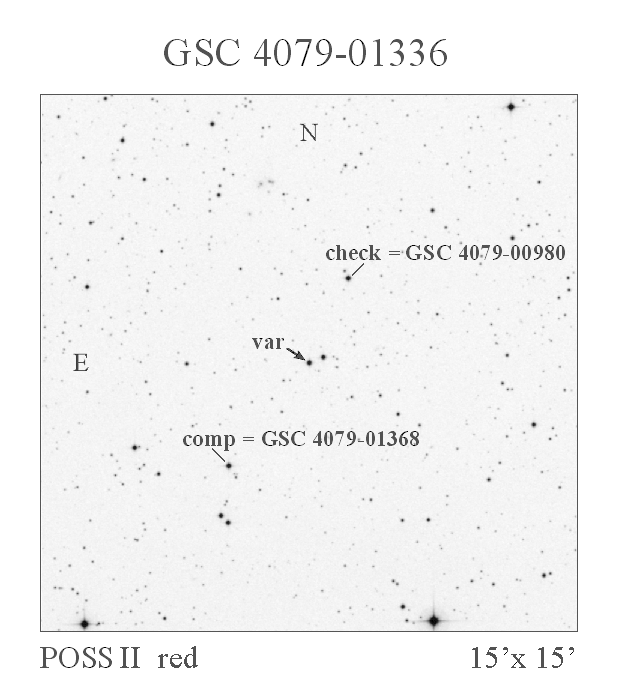| Article in PDF |
"Peremennye Zvezdy", Prilozhenie, vol. 8, N 12 (2008) |
GSC 4079-01336 is a New Algol-Type Eclipsing Binary
A. V. Khruslov#1, A. Samokhvalov#2
#1 Russia, Tula
#2 Russia, Surgut
#2 Russia, Surgut
| ISSN 2221–0474 |
Received: 9.02.2008; accepted: 29.02.2008
(E-mail for contact: khruslov@bk.ru, sav@surgut.ru)
| ||||||||||||||||||||||
Remarks: |
| We present the results of our study of the object NSVS 2181598 that is a blend of
two close
stars: GSC 4079-01336 and GSC 4079-01910. From NSVS data (Wozniak et al., 2004),
A. Khruslov detected variability of eclipsing character, but the ROTSE-I angular
resolution is insufficient to determine
which of the two stars varies.
During an expedition to the North Caucasus Astronomical Station of Kazan State University in January 2008, A. Samokhvalov performed observations of the object using an Intes Micro Maksutov - Cassegrain telescope (D = 150 mm, F = 900 mm) and a SBIG ST-7XMEl CCD camera. Basic reductions of images for dark current, flat fields, and bias, as well as subsequent photometric reductions, were carried out with the MaxIm DL software. A total of 596 images with 5-minute exposures in the Bessell V filter were obtained on 11 nights (JD 2454471 - 2454481). The comparison and check stars were: comp = GSC 4079-01368, check = GSC 4079-00980 (see the finding chart). It was found that the actual variable is GSC 4079-01336; its coordinates in the table are from the 2MASS catalog. The epochs of primary minimum, determined from our photometry using Peranso 2.31 software, are: HJD 2454474.2240; HJD 2454475.3933; HJD 2454476.5572; HJD 2454481.2279. Based on our CCD observations and NSVS data and using Peranso and WinEfk software, we determined the period of GSC 4079-01336, P = 1.1670805 +/- 0.0000010 days. To plot the phase curve, we use the tabulated ephemeris. The Figure shows the phase curves for our CCD observations (top) and for the NSVS observations (bottom). The V-band amplitude of the main minimum is 2.78 mag; the primary-eclipse duration is D(min I) = 0.19 P; the V-band amplitude of the secondary minimum is 0.125 mag; the secondary-eclipse duration is D(minII) = 0.17 P; the phase of the secondary minimum is 0.5017 +/- 0.0004 P. Acknowledgements: We would like to thank the expedition team (T. Kryachko, D. Denisenko, S. Korotky, K. Sokolovsky, D. Chekhovich) and a staff observer of the North Caucasus Astronomical Station of Kazan State University S.V. Solovyov for helpful discussion. We acknowledge the use of the period-search software WinEfk developed by Dr. V.P. Goranskij for Windows environment. |
| References: |
| Wozniak, P.R., Vestrand, W.T., Akerlof, C.W. et al., 2004, Astron. J., 127, 2436 |
Light Curve
Finding Chart 
Data Source |